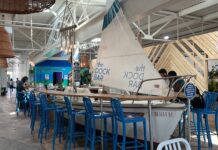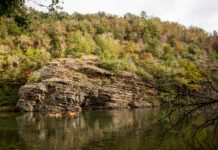Designing Minds
Creating something out of nothing, seeing order in chaos and finding inspiration in the seedling idea are traits these Oklahoma designers and architects exhibited when tackling some of their most unique projects.
It takes a visionary quality and even a child-like sense of possibility to take a concept from a client and bring that to life before their eyes. Be it a garden of glass or bringing a bit of history to the present with an added modern touch, imagination is key for a designer.
Using that imagination, these experts have brought their clients’ visions to life in projects as fascinating as the people themselves.
Dreaming in Color
When a close friend came to designer Christopher Murphy and asked him to take underutilized space and create a unique backyard she could enjoy, she gave him the one parameter every designer dreams of – freedom to let his imagination run wild.
“I got to dream,” says Murphy, of Christopher Murphy Designs, about his approach to the project.
The result was an exquisite private glass garden featuring a kaleidoscope of vibrant colors accented with white stone “lily pads” and meticulously planned landscaping.
Murphy’s design communicates a sense of waves of energy all while working with the Nebraska countryside that surrounds the home.
“She now has a piece of art in her landscape,” Murphy says.
He adds that the owner is able to enjoy the garden from a private deck above or by getting right in the middle of things on one of the large-scale lily pads complete with a rotating reading pod. Glass side tables and a modern fire pit unite comfort and function.
The glass garden is comprised of 16 tons of recycled, tumbled glass, permitting the owner and her dogs to walk around the space easily; as well as more than nine tons of polished white rock, each placed by hand.
Continuing a theme of movement and “waves,” Murphy placed a modern fountain, katsura tree and an arresting sculpture, entitled Flight, by artist Shannon Hansen, among the white stone lily pads, or “crop circles,” as the designer has jokingly dubbed them.
“The glass garden is beautiful year round,” explains Murphy.
According to the designer, in rain it darkens, in the bright sun it glistens, in the fall it’s a riot of color after the leaves have gone and in the snow it peaks through, coloring a blank canvas.
An added benefit for the owner is that the reflection of the glass creates a micro-climate by the retaining wall garden area, which allows her to enjoy plants that otherwise might not bloom.
For both the homeowner and designer, the space is literally a dream come true.
Artistic License
The eye-popping residence of artist Michelle Martin-Coyne and her husband, Flaming Lips frontman Wayne Coyne, is as much the creative haven one would imagine the home of two artists could be.
Complete with mirrored glass portals, an all-white tiled master bath affectionately dubbed “the pod,” and a mosaic floor with a skull motif, the home is a living, evolving work of art.
The couple collaborated on their Oklahoma City home with Brian Fitzsimmons and Larry Pickering of Fitzsimmons Architects to create a master plan of phase one for the six adjoining properties, which are all part of what is referred to as the “compound.”
“There were quite a few challenges in the demolition phase and quirky bits like crooked and leaning walls. It fought with us a little,” says Pickering.
Fitzsimmons explains it as “responding to the ghost of Beasley,” referring to Tom Beasley, the architect of the original home built in the 1930s.
The renovation included turning a three-car garage and an attached apartment into the main living area. To bring this modern space about, they literally raised the roof on the rock icon’s house, which, along with a large wall of sliding glass doors, brings indirect sunlight to the space. Indoor and outdoor spaces were also united by the use of recycled granite flooring in the living area, which spills out of doors.
The home design was marked by creative invention. When tackling the master bath “pod,” the designers’ approached it like an inverted pool and turned what had been a breezeway to a separate structure into a yoga room.
“What made the project so special and unique was the collaborative work with Michelle,” says Pickering. “Working hand in hand to create their vision was the best part.”
He adds that many spaces were created as a blank canvas for Michelle to infuse her artistic touch, including the master bedroom skull mosaic.
The project itself wasn’t just about renovating a home, but an investment in the future.
Having grown up in the area, Wayne decided to take a hands-on approach to jump-starting a revitalization of the sometimes troubled neighborhood. By making a commitment to stay in the area they are inspiring others to follow suit.
The Gathering Place
Instead of trying to fit their lifestyle wants and needs into a renovation project, the owners of this luxury Tulsa residence enlisted the help of veteran architect Jack Arnold to help create a completely new space in a location they already loved.
“The home had an indoor pool, and our plans always ended up having to change because of that space,” says Arnold of the design to knock down their old home and start from scratch.
They loved the location and the neighborhood, but the couple wanted a space where they could host and entertain friends, family and church group.
In the old home’s place Arnold created a multi-level Italianate style home complete with the traditional barrel tile roofing and stucco exterior. The home includes the best of both worlds in that it exudes Old World elegance in an open floor plan fit for modern living.
For this luxury residence, the architect, along with with interior designer Hari Lu Ames, designed the space around the concept of circulation and flow. Whether the couple is entertaining 10 or 100, the layout and ceiling design are created to give a sense of intimacy along with spaciousness.
“It’s designed so people feel comfortable even in a large scale,” shares Arnold. He adds that often in older floor plans, guests can end up feeling trapped in a room with only one exit.
At the heart of the design lies the detailed kitchen featuring a large island that serves as a gathering space. Flowing seamlessly out from the kitchen is the great room and family area and beyond that a set of French doors will take guests to the outdoor living and cooking areas.
A design element Arnold employs to create a visual flow as well is to transition the limestone kitchen flooring into a blend of limestone and wood patterned design that makes a complete transition to walnut flooring in the great room.
Old World touches, such as the copper chimney pots designed by the architect himself, as well as intricate beam work and antique pieces the couple found during their travels, mix seamlessly with modern updates like their geothermal system.
“We didn’t look at this as just a house, but a whole project,” says the architect.
The calm palette, manicured vistas and exquisite water features of the residence are the perfect backdrop for the real focus of this home, which is the friends and family that enter.
Period Piece
Both passionate about historic preservation, Jane and Steve Holcombe were determined to restore their American foursquare home to the former glory of its historical architecture.
“The original home had these beautiful brick dormers on the facade that for some reason had been modified,” says architect Randy Floyd of the two ornate designs that are featured on the front facade of the home.
Floyd believes either the weight or possible weather damage was the cause of removing such artistic limestone caps, located on both sides of the facade, along with part of the quatrefoil windows which feature clover-like patterns.
Based on original pieces of the limestone caps and a 1911 photo of the original construction, Floyd and her team recreated the two dormers brick by brick.
“It took a lot of work,” says Floyd of meticulously studying the photo among other techniques to deduce the design.
She adds that her favorite part of the job was the investigative element.
“I loved crawling around in the attic, being up on the roof taking measurements – it’s like solving a puzzle. That’s what architecture is to me and I guess that’s why I find it exciting.”
To avoid the weight issues, which might have marred the original construction, Floyd decided to infuse the restoration with the modern innovation of fiberglass reinforced concrete. The lighter material was reinforced with a metal stud and the ornate caps were cast to recreate the original look. The soft yellow exterior was once again a piece of art as well as part of the city’s history.
Located in Heritage Hills, the home is zoned for historic preservation – a passion Floyd shares with the homeowners.
“It’s so important for cities to tell their own story and show what the buildings looked like 100 years ago,” says Floyd. “I think it gives people a sense of place to see how it evolved to where it is now.”
The evolution of this home was clear for all to see when it was featured in Heritage Hills’ 2011 Parade of Homes and used on advertisements, making it a poster child for restoration and historical preservation.
Mad Hatter
Broken Arrow native Jake Kelsey is a man with many hats, and in the over-the-top world of Project Runway alum Chris March, it’s safe to say you could call him somewhat of a mad hatter. As March’s personal assistant on Bravo’s Mad Fashion reality show – which centers on March and his New York City-based boutique – Kelsey is part of a crew of fashion misfits that caters one-of-a-kind designs to March’s high-profile clientele, and the aspiring actor is having a ton of fun along the way.
Oklahoma Magazine: How did you come to be on Mad Fashion?
Jake Kelsey: I went to the Circle in the Square Theater Arts School in New York, and have been living here for four years. I was working at Barney’s when I was approached by someone from the show. They needed to fill a spot for Chris’s assistant and asked if I was interested in interviewing. It sounded like a lot of fun. Right after I interviewed, I found out I got the job and they were ready to start filming.
OM: Once the ball got rolling, what was the chemistry like on set?
JK: It really was a match made in heaven – we got along so well. I really became close with Chris and the rest of the team. Everyone is their own unique, crazy person – we all just mesh together to make this one cohesive crazy machine. I’m the youngest one, so I automatically took the little brother role for everyone to pick on and that’s totally okay with me.
OM: What kinds of things do you assist everyone with?
JK: Anything and everything. They definitely keep me on my toes. I had never been an assistant before, certainly not in the fashion world. It’s fun to have someone important trust you with a bunch of different jobs and get to help with such amazing projects, like Chris’s designs. I’m there on camera on the set a lot, but also, what you don’t really see is that I’m running around constantly. I may leave the studio 10 times a day to go uptown or downtown to a feather store or trim store or a bead store and other places.
OM: Do you take some of these things you’ve picked up on in the fashion world home with you?
JK: I definitely do, but I always try to tone it down a bit when I come back to Oklahoma. If I’m going to Walmart, I’m not going to wear my crazier clothes. I’m a six-foot-three redhead, and I essentially stick out anyway, so if I’m wearing some wild New York outfit people are just going to be looking at me even more.
OM: What have been some of the more off-the-wall tasks Chris has assigned you?
JK: One of our clients was Susanne Bartsch, and she’s really off the wall. She’s like the Elvira of the fashion world, wearing avant garde and gothic things all the time. I had to go to a few different gothic stores and look at stuff like chains and spikes and body armor for her dress. That was kind of crazy. I had to get 200 bras for (style expert) Jene Luciani’s bra dress. That was a great one.
OM: Beyond Mad Fashion, what would you like to get into in the entertainment industry?
JK: I still really love acting. I’m leaning more into the film and television world now that I’ve been on camera.
OM: Any favorite shows?
JK: Modern Family, 30 Rock, Happy Endings – those shows are hilarious. I’d love to do comedies like those. It’s funny – everywhere I go, I get people calling me Jesse Tyler Ferguson, the redhead from Modern Family. I get it all the time – people yell his name or his character’s name at me on the street or in bars. My mom has even written the show an email telling them I should be on the show as his brother or something. I’m like, “Mom stop!”
Building On Tradition
There was a time when Tulsa was proud of its downtown. In those days, you could take the trolley in from Sand Springs and join the bustling crowds thronging Main Street and its huge department stores. You could tell your family, truthfully, that you’d have to go to New York or Chicago to see finer buildings than the tall, graceful Art Deco towers one block east on Boston. If you were lucky, you could catch a glimpse of the burnished brass, exuberantly sculpted marble and gleaming mahogany inside the fabled Philtower.
Now the excitement’s back. Go inside the Philtower lobby any weekday after 5 o’clock, and those glowing, sculpted walls ring with laughter and happy voices. Follow the joyous noise around the corner and step inside Edward Delk’s. Go past the tables filled with young professionals who stream in from nearby office towers, and chances are you’ll see the owners Eric Richards and Hunt Hawkins standing by the bar. Young professionals themselves (Eric, dapper and bespectacled, is a financial analyst; Hunt, tall and lean, an oilman), they fit right in.
“Before we built this place,” says Richards, “if you wanted to unwind after work downtown, there was no place to go.”
“And if you wanted food,” Hunt chimes in, “there was nothing but Domino’s Pizza. I got mighty tired of pizza.” For years, Hunt and Eric dreamed of opening a dapper professional hangout to satisfy these needs.
“We wanted two things,” says Richards. “(To pay) homage to the architectural district and a big city feel.” That’s why they named it after the well-traveled cosmopolitan architect who designed the Philtower: Edward Delk.
Like Delk, the two business partners lavished attention on each architectural detail. The marble that tops the tables comes from the Philtower lobby. The floor is original, carefully restored after years buried under linoleum. A huge chandelier, its crystals shimmering, shines on enormous reproductions of Delk’s original architectural drawings. Nearby, a spiral staircase from the tailor that originally occupied this space (Brenner’s) leads to a balcony above. Details, such as tufted leather sofas, black carved moldings, the metal sculpted bar back, and even the old-fashioned light bulbs, hint at the gilded age when the Philtower was new. The exposed brick walls and, high above, the pipes and crossbeams of the ceiling, have a more modern feel.
“We merged industrial with Art Deco,” says Richards.
Bearded and elegant despite his casual clothes, Tuck Curren hears Richards and strolls by. One of Tulsa’s great restaurateurs, owner of Biga and Local Table, Curren designed the menu, and he’s excited about it.
“It’s bar food,” he says. “Plates designed to share after work, but it’s bar food taken to a higher level.” One popular dish, the Brie and Wild Mushroom Fondue, looks simple. But, Curren explains, it’s not. Butter and flour are combined to form a roux and dried Porcini mushrooms added to form a version of a classic French Béchamel. Brie and Shiitake mushrooms are tossed in, and then the dish is baked in a pizza oven. The finished product is highly addictive and unforgettable. If you’re still hungry, there are some fine panini: housemade pastrami, beer-braised short ribs, chicken with pungent roasted peppers. Panini means “little breads,” but these hefty hoagies are far from little. Or there are salads, soups and pizzas. The owners favor the beef short rib pizza with barbecue sauce, but the Margherita, heaped with tomato and fresh mozzarella, looks like something that came out of an oven in Naples. If it’s drinks you’re after, there are some fine craft beers, a hundred kinds of liquor and some nifty cocktails with names like “Bitter Love” and “The Smoking Gun.” Edward Delk, sophisticated and cosmopolitan, would have enjoyed that.
Reinventing Roy
A half-dozen years ago, in his Tulsa office, Roy Clark told me something I’ve repeated dozens of times. To me, it remains the best explanation of an artist’s creative drive that I’ve ever heard.
It came at the end of a long interview, which I used in writing the copy for his 2007 tour book – the souvenir publication offered for sale at concerts. That year, he was celebrating the 60th anniversary of his entry into show business, and he and his management had commissioned a special tour book to mark the milestone.
The tape recorder was off, and I was getting ready to leave, when he gave me his personal spin on the old “ladder of success” metaphor. It’s stuck with me ever since.
Starting out as a green kid, he told me, he saw stardom as a ladder, stretching high into the clouds. So he began to take it a rung at a time. First rung, playing in his father’s square dance band in Washington, D.C., beginning a few months before his 14th birthday. Second rung, doing radio and television around the area. Third rung, branching out into clubs as well as square dances. Fourth rung, fronting his own group.
Higher and higher he climbed, past a lot of other aspiring stars occupied with their own ladders, as his fame spread. National television. Hit records. Big concerts. Honors and accolades. Always he climbed, his face inclined toward what he thought was the ladder’s end.
“And then, one day after all those years, I stepped up another rung and finally, finally, stuck my head through those clouds.” He grinned. “And do you know what I saw?”
I said I didn’t.
He gazed upward, gesturing toward the sky. “I saw that ladder,” he said, “going on forever.”
Pausing to let the observation sink in, he added, “When I was starting out, if somebody had said, ‘What do you want to be? Do you want to be a star?’ I would’ve said, ‘Yeah. Sure.’ But what is a star? I found out later that on the ladder of success, the higher you climb, the more rungs there are. So you never reach that absolute top. You’re never satisfied. If you’re satisfied, you quit.”
Some 65 years after he first placed a tentative, youthful foot on the very bottom rung, Roy Clark is still not satisfied, which is to say that he’s not about to quit. In fact, over the past couple of years, he’s been continuing to expand his fan base by intentionally getting before audiences that may not know very much about him at all.
A perfect example came a few months ago at Tulsa’s BOK Center, when he joined country star Brad Paisley, more than a generation removed from Clark, for a guitar duet on the classic “Ghost Riders in the Sky” that earned a standing ovation from the huge crowd.
“When Brad Paisley was a kid, 14 or so, he went to the Capitol Theatre in Roanoke, Virginia, and saw Roy,” notes Jim Halsey, the Oklahoma-based impresario who has guided Clark’s career for decades. “He even performed a number on the show with Roy. And when he invited Roy to join him onstage at the BOK, he said, ‘I learned to play guitar from your Roy Clark Big Note Songbook.’
“Roy is a universal artist,” adds Halsey, “so it’s not like he has to learn something new or do something different. We just have to have him do something that gets the attention of a different audience.”
Halsey calls that process “reinventing,” explaining that it’s something that Clark has been doing his whole career. “From the very beginning, this is something we did together. Roy would reinvent himself almost daily sometimes, depending on the situation. He’d go from a bluegrass festival to the Montreux Jazz Festival, from playing with symphony orchestras to acting in dramatic television to guest-hosting The Tonight Show. I would go any place and make a pitch with him, trying to get him into something different, someplace where he wasn’t expected to be.”
Such as, in 2010, onstage in a giant arena with a hit-country-radio act like Paisley.
“‘Reinvent’ is really a good expression,” says Clark, “because that’s the thing that I’m doing now. There are young people who are not aware of who Roy Clark is. So what we have to do now is come back and reinvent ourselves. Every concert we do, God knows how many people tell me, with that little sly smile on their faces, ‘I grew up watching you.’ But the folks who grew up watching me are getting older every concert tour, so you just have to get in there and hopefully get some of the young people to come out to the shows.”
Young artists like Paisley and one of his supporting acts at the BOK concert, Darius Rucker, are certainly helping. “Darius Rucker just went crazy over Roy,” notes Halsey. “Everybody uses a bunch of big television stuff now in their concerts, and when Darius Rucker played here (in Tulsa) a few weeks ago, on one particular song, he was showing pictures of the OU football team and stuff like that, and then suddenly, on this big 60-foot screen, is an image of Roy Clark.”
Both Clark and Halsey also credit reruns of the iconic television show Hee Haw, now playing on the cable outlet RFD-TV, with helping keep his name and face before new audiences. As Clark fans know, the show originally began airing in 1969 as a kind of countrified version of the then-hit sketch-comedy series Rowan & Martin’s Laugh-In.
“When they came to me with the Hee Haw idea, Frank Peppiatt and John Aylesworth, I was a guest on The Jonathan Winters Show,” recalls Clark. “They were the producers. This was September of ’68. They came to me and said, ‘We have an idea about doing this television show, not unlike Laugh-In.’ That was the way they phrased it: not unlike Laugh-In. ‘Would you be interested?’ Of course, you say yes to everything, because a lot of it never happens.”
Hee Haw, however, did happen, and in a big way. Although Clark was already a well-known national television presence and recording artist in 1969, when the weekly show debuted, his work as co-host (with fellow country star Buck Owens) on Hee Haw made him a household name. The show originally ran for an amazing 23 years, far outliving the program that inspired it.
“I’ve gone through the grandparents, the parents, and the kids who were forced to watch Hee Haw,” laughs Clark. “They’d sit there and say, ‘Oh Lord, do we have to watch this thing again?’”
Although the program was unabashedly and intentionally cornball, it has achieved iconic status. For proof of that, all you have to do is visit Pickin’ and Grinnin’: Roy Clark, Hee Haw, and Country Humor, an exhibition running through May at the Oklahoma History Center in Oklahoma City. Focusing on Hee Haw’s ties to our state, it’s an impressive multimedia presentation that’s already been viewed by thousands.
“It’s extremely popular, especially with the people who grew up with the show,” says Larry O’Dell, the Oklahoma History Center’s director of collections. “The school kids coming through like it, too, because we show clips and they can see how corny and funny it was.”
When the Center first approached Clark about doing an exhibition on him and his work in Hee Haw, he wasn’t entirely sure of the concept. “The first thing you wonder is if you’ve actually done enough to warrant an exhibit,” he says, chuckling again. “When somebody all of a sudden says, ‘We’re going to make an exhibit,’ you immediately start thinking, ‘Well, how much are they going to need?’
“You figure when they say they’d like to do a hysterical – as opposed to historical – exhibit, that it’s something that’s going to be way down the road,” he adds. “So they say, ‘We’d like to do this,’ and you say, ‘Yes, that’s quite an honor. Thank you.’ – figuring it’s not going to happen right now. Next thing you know, they’re saying, ‘We’re ready to go,’ and it’s like, ‘What do you mean you’re ready to go? This wasn’t supposed to happen until later.’
“The longer you’re in this business, the more you get to thinking that what you’re doing now is what you used to watch and listen to others do – and now you’re the one they’re zeroing in on.”
A case could be made that being the focus of a museum exhibition just takes him to another rung on the ladder, as do such recent career milestones as his receiving the Gene Autry Spirit of the West Award from the Autry Center in Los Angeles, being named Oklahoma’s Musical Ambassador for Children by Gov. Mary Fallin, and lending his name to what is now the Roy Clark Music School at Northeast Technology Center in Claremore.
Halsey places these honors under the “reinvention” heading, and re-emphasizes that it’s the kind of thing his longtime client and friend has been doing throughout his professional life.
“A lot of people don’t know that Roy Clark was the first country-music artist to play with a symphony orchestra using symphony charts,” Halsey says. “The first time we did that was with Arthur Fiedler and the Boston Pops in Oklahoma City, 1962. We had (noted music figure) Richard Hayman write the arrangements, and those arrangements could take Roy anyplace from a Tonight Show audience to a major fair. Back in the late ‘50s and early ‘60s, most of the state fairs had variety-show productions, and they had a house orchestra of 18 to 25 pieces. Your Frank Sinatras, your Perry Comos, would have their arrangements and bring in their conductors and do their sets.
“We started talking to fair managers, asking, ‘Why don’t you let us come in with a country-music show?’ They’d say that wasn’t what people expected. And I’d say, ‘Well, let’s try it.’”
So Clark would bring in his charts and do the shows, and pretty soon, he and other Halsey acts like Wanda Jackson and Hank Thompson became staples of the fair circuit, paving the way for many other country performers. At the same time, Halsey was expanding into Las Vegas – and, he points out, “Roy Clark was the first country artist to really play the Vegas strip. Hank Williams had played the Last Frontier in 1952, but that was about it.”
All reinventions, all rungs on the ladder. And after six-and-a-half decades of hard, solid, work, Roy Clark is still climbing, still thinking about that ladder whose very top he’ll never see, whose end he’ll never reach.
“I don’t know of anybody – not even Garth Brooks or any of the other ones we look at now with their millions and millions of record sales – who sees the end,” he says. “There’s no end to it. You’re never satisfied. And you wonder, ‘What rung am I on now, compared to the rest?’ You know, there are the Hank Williamses and a few others who are easy for us to look at and say, ‘Well, that’s the top of the ladder.’ But the more you get into it, the more you think about you climbing that ladder, the more you realize that people have fit you into rungs you never thought you’d reach, You never thought you’d make it that far. You weren’t even counting the rungs, because you were too busy working.”
He grins again, the impish smile that’s been seen by untold millions of television watchers and concertgoers, and that will undoubtedly be seen by many more. “I’ll tell you this,” he concludes. “I don’t feel that I’ve missed a single rung. I don’t say I’ve done it all. I’m not quite sure what ‘all’ is. But what I’m aware of, I’ve done.”
21st Century Outdoor Living
When Bob and Carol Skib moved into their new home – a renovated downtown Tulsa industrial building – the backyard was still the building’s decades-old black asphalt parking lot. Several months later, the couple was ready to tackle the outdoor space and enlisted landscape architect Carl Szafranski of Szafranski-Pugh & Associates for guidance. After some initial collaboration with the project’s architect, James Boswell, Szafranski began lengthy interviews with the couple “so I could understand their emotional and functional needs for the space.”
The Skibs had already determined they wanted a pool, spa, outdoor fireplace plus a layout that was conducive to entertaining, from small intimate gatherings to large events of several hundred. And because of the uniqueness of the residence, the intention was to blend any additional architectural and design features with the warehouse/industrial style.
“We utilized an existing metal shed and transformed it into their garage,” says Szafranski.
Nearby rusted I-beams with a retractable Sunbrella fabric cover by Tulsa Awning creates a cozy seating environment overlooking the pool. And as a nod to the industrial theme, the fireplace cover was custom made by Garden Deva’s Lisa Regan to replicate an incinerator door.
To meld the hard surfaces required for the patio, pool deck and motor court, Architectural Paving Systems used natural, non-pigmented concrete with a rock salt finish. And to avoid a “heat island,” the cement was poured in rectangles and divided by ribbons of grass, creating a year round architectural vision. Bob Skib was so intrigued with the process and work of the concrete crew, he likened it to “watching a symphony in progress.”
Since there is a tendency for an echo to occur behind the house, Pool Creations Inc. created a swimming pool with a series of small waterfalls to provide the subtle sensation of moving water without it being so loud it requires shouting. The pools’ “wet decks,” submerged nine inches under water, are large enough to hold a chaise lounge and are favorite spots to cool off on a hot summer day. And the spa is an enticing place to relax near the fire on a chilly winter evening. Anticipating using the outdoor living area year round, numerous umbrella sleeves are installed throughout the back yard, providing the flexibility to have shade based on where it is required at various times of the year.
The Skibs are thrilled with the results of their challenging project and have been gracious in sharing their unique abode with the community. The couple has hosted several fundraisers with the most recent having more than 200 in attendance enjoying live music outside.
Creating functional outdoor living areas requires more thought and planning than just maintaining a visual flow of styles, colors, and finishes from inside to out.
“I always approach the exterior by starting with the view from inside,” says Szafranski.
And landscape architect Clare Ashby, ASLA agrees. For homeowners considering adding an outdoor living area, she suggests brainstorming all the various ways the space might be used from family gatherings to adult entertaining.
Gone are the days when using the backyard was relegated to summertime.
“We consider the design from a year round perspective,” says Ashby, who anticipates how all the plant materials appear at different times of the year.
Looking beyond the explosion of spring color, Ashby specifies ornamental grasses and sedum for visual interest peaking in the hot months of July and August. And she is not a fan of the continually blooming Encore Azalea preferring “fall colors in the fall.”
In the summer the sound of water, shade elements, ceiling fans and misters cool down the Oklahoma heat, while the winter requires protection from the north wind, and either stand alone or installed heating systems will warm up the frigid night air. Outdoor living areas are now approached with the same level of detail and planning as any interior space.
“Design doesn’t stop at the exterior wall anymore,” says Sarah McPhail, interior designer at Tulsa’s SR Hughes. “We see luxury homes now including outdoor spaces as part of their initial design.”
Plus, additions of multipurpose outdoor living areas in existing homes are increasing in popularity.
“Ten years ago, an outdoor kitchen was a grill with cabinets below,” says Jack Wills, president of Jack Wills Casual Furniture.
And it was typically considered the man’s domain. Now the “outdoor culinary center” has evolved to include interaction with the entire family. No one is stuck inside prepping the food, and there’s no messy transferring it outdoors to cook, since everything is done outside. The ultimate outdoor kitchen has three stations – food prep, cook station and the serving area. And since outdoor kitchens require storage for dishes, utensils, spices and other ingredients, today’s dry pantries are constructed so they are not a haven for bugs and spider webs.
According to Wills, outdoor appliances have also evolved. In the past, under-counter refrigerators were primarily for snacks, soft drinks and beer. Now, outdoor refrigerators are engineered to withstand temperatures up to 120 degrees, and if the door is accidentally left open, there is a built-in recovery system.
“It’s like having your thermostat on cruise control,” Wills explains. “If the interior temperature hits 50 degrees a blast of cold air brings it down to 38, keeping food from spoiling.”
And the options of the technologically advanced built-in outdoor smokers, grills and cooktops have evolved significantly beyond the ubiquitous portable barbeque grill.
Waterproof flat screen televisions are popular for outside viewing although the traditional nearby fireplace is in decline.
“Over the last five years, we’ve seen the fire pit become more popular than a fireplace,” says Wills.
The design and layout is often preferable for families and those who frequently entertain since a bench seat surrounding the fire can seat up to eight or more.
By utilizing gas jets and colorful glass toppings, the fire pit becomes a creative focal point. Gas allows the homeowner to enjoy a fire without the time it takes to build a wood fire.
“Plus you can enjoy a moment by the fire and be dressed to go out or even ready for bed without smelling like smoke,” adds Wills.
“Remote control availability is a popular option with fire pits,” says Jeff Vivion, president of Vivion Pools, Inc. Smartphone apps set to regulate automatic fires, elaborate sound systems, landscape and pool lighting, and even the spa are one of the latest trends in outdoor living. “You can turn on the spa while driving home from work and it is already heated by the time you get there,” Vivion explains.
Water features including a swimming pool, spa, fountains and waterfalls are key elements for the backyard resort.
According to Vivion, ease of maintenance is often first on the list of requirements for any type of backyard water feature. In-floor pool cleaners and saltwater systems are popular while ozone systems, previously available on the coasts are now options in the Midwest. While the appropriate size, shape and overall layout of pools is custom to each residence, Vivion says he’s seen the trend move away from curved designs accented with ceramic tile and boulders to a sleeker, modern style with clean lines, glass tile and water features utilizing stainless steel or copper. And as an alternative to plaster and the passé natural pebble finish is the new technology featuring sparkling, colorful glass beads or processed seashells, creating a dazzling dance of color through the water.
As the popularity of outdoor living spaces has soared, McPhail has noticed a change in textile technology and design.
“Just a few years ago, outdoor fabrics had limited design options,” says McPhail. “Plus they just didn’t feel very comfortable.”
Today, popular fabric lines are introducing outdoor fabrics with softer, plush textures in a range of patterns and colors making it even easier for the interior design to flow outside. In addition to furniture upholstery, outdoor fabrics are important elements in creating curtains and awnings to block the sun and the wind.
McPhail also sees advances in other outdoor products, including EcoSmart’s portable bioethanol fireplaces and fire pits, perfect for flexibility in creating a cozy focal point whether dining, relaxing by the television or lounging by the pool.
Homeowners should use the same criteria planning their outdoor space as they do creating their interiors including budget, function, space availability, traffic flow, architectural style, color preferences and year round use. Create a master plan even if the project will be created in phases. And consider a few hours consulting fee with a professional designer or landscape architect as a valuable investment even if your intention is to ultimately do-it-yourself.
“Our job is to be creative within the budget and design requirements,” adds Ashby.
Despite the extremes in Oklahoma weather, more and more homeowners like Bob and Carol Skib are creating spaces to enjoy life outside. “It’s our favorite ‘room’ of the house,” says Bob of their impeccably designed outdoor retreat.
Creative Vision
“You live where?”
That’s the quizzical refrain Jason and Meridith Smith are accustomed to hearing since the couple moved into their renovated downtown loft in Clinton, Okla., nearly two years ago. The couple embraced relocating from Argentina to Clinton for a job opportunity since it brought them back home to their Oklahoma roots. But they missed the urban lifestyle.
“After looking at available houses, Jason explored potential downtown buildings,” says Meridith.
The classic 1926 two-story red brick building the couple eventually purchased was typical of the era with retail space downstairs and offices above. The second story, a maze of attorney and medical offices, had been vacant since 1964, but Jason and Meridith saw the potential.
“We were on a tight budget so the goal was to do as much as possible ourselves,” Jason says. That included drawing the plans to get city approval. The 3,000-square-foot space includes three bedrooms, two baths and open living, dining, den and kitchen areas. There is also a studio for Jason’s music production and a work area for Meridith’s online business of handcrafted baby items. Plus, there is a room for a future climbing wall.
At night and on weekends, with the help of family and friends, the couple began the 18-month renovation, initially with no air conditioning and with a single light ran from an extension cord downstairs.
After discovering the old brick under the lath and horsehair plaster, the homeowners decided to expose it all, a laborious process concluding with a muriatic acid wash, rinsing and sealing the 14-foot walls. After tearing out the drop ceiling, they wanted to leave the structure above exposed.
“So I built a two-by-six-inch frame on top of the roof where I installed insulation,” says Jason. Through it all, the only contractors hired were the plumbing and electrical crews and toward the end, a sheetrock crew. “Those guys did in three days what would have taken me weeks,” he says.
Jason figured out how to jack up the sagging floor and designed – then built – the open fireplace, which doubles as a structural component. But his ingenuity to get what he wanted within budget is most evident in the massive, 18-by-14-foot walnut bookshelf.
“I wanted walnut, but it was too expensive,” Jason explains. So he cajoled a friend into letting him cut down walnut trees on their family acreage and had them milled locally. “It would have taken a year for the walnut to dry naturally, so I found (instructions on) how to build a kiln,” says Jason. He and a buddy built a 14-foot kiln out of scrap material, and before long he was building his walnut bookcase.
The Smiths successfully intertwined creativity with their budget. Each stair tread was individually crafted insetting exotic Bubinga wood in inexpensive pine, and on the floors they installed four-inch pine boxcar siding at a third of the cost of traditional oak planks.
They couple estimates spending around $800 for the kitchen. IKEA was the affordable source for cabinets, shelving and light fixtures. They spotted the vintage ‘50s stove while at a local tire store and took it home for $50. And the used $100 basic white refrigerator was transformed into an artistic focal point when Meridith applied chalkboard paint. Nearby are chairs from her grandfather’s, spray-painted turquoise.
Their Mid-century Modern sofa cost just $125. “And that included cleaning the upholstery,” says Meridith. “Clinton has a hidden niche of inexpensive vintage furnishing and accessories for sale.”
The Smith family now includes two little boys, so Jason has plans to expand their 500-square-foot rooftop “yard” to 3,000 feet. Life in the downtown loft is still as fun as they envisioned it would be, the couple agrees.
Fasting Facts
Fasting is a practice often equated with religion, where individuals give up a specific food, or all food, for a certain amount of time. However, fasting can be done for many reasons, such as body detoxification, weight loss or in preparation for a medical procedure.
In reality, we all fast a little each day, says Sonja Stolfa, a registered and licensed dietitian with St. Francis Hospital. Our bodies fast every night when we sleep. For that reason, it is recommended that a person eat one to two hours after waking up in the morning.
“Prolonged fasting is not sustainable and only serves to slow down the body’s metabolism,” says Stolfa.
During the fasting period, if a person is eating very little to no food, the body begins to pull from its fat storage. However, as soon as he/she begins eating again, that fat is regained.
People who maintain minimal eating habits for years will, over time, experience decreased kidney function and a weakened heart.
Serena Mitroo, an internal medicine doctor with OU Physicians in Edmond, recommends six months to a year of healthy eating and exercise to create maintainable weight loss.
For anyone considering a short-term fast, fluids should continue to be consumed. Otherwise, the body will soon become dehydrated and hospitalization may be required.
After a few days of consuming only liquids, individuals will begin to feel fatigued. They want to be careful not to overexert themselves, Mitroo says.
Individuals who cut meat or dairy from their diets need to make sure they are receiving vital nutrients, such as zinc and B vitamins, from other sources. Otherwise, they may deal with long-term deficiencies.
Fasting can also be used as a way to cleanse the body of toxins, but that’s the job of the liver and kidneys, says Stolfa.
Instead of starving the body, Stolfa recommends eating more fresh fruits and vegetables and avoiding processed foods, which usually contain toxins and hormones.
“Good food gives the body a boost of energy,” says Mitroo “We should always be eating food that provides hydration and nutrients.”























